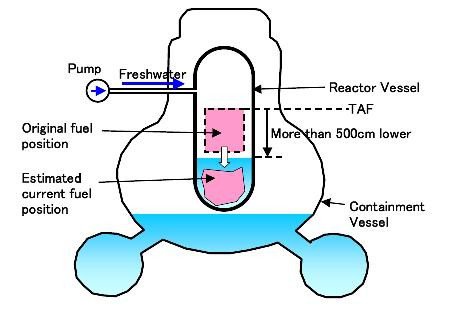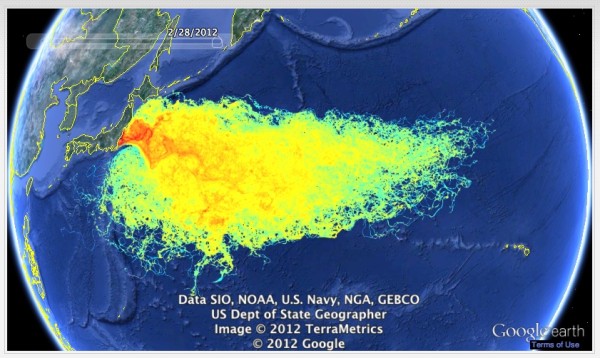On March 11, 2011, a Magnitude 9.0 earthquake occurred 70 km from the coast of Japan. The resulting Tsunami (or tidal wave ) was 40.5 meters in height and traveled up to 10 km inland from the coast. The resulting level of devastation hadn’t been seen in Japan since the Second World War.
The Fukushima Daiichi Nuclear power plant was a BWR nuclear power plant ( Boiling Water Reactor – a type of reactor that utilizes boiling water to create electricity ) situated on the coast of the eponymous Fukushima District.[1].
When the Tsunami collided with the infrastructure of the plant the results were as devastating as they were predictable. When 15 meter waves disabled the power supply and cooling systems of three reactors, all three cores largely melted within the first three days [2]. This occurred largely due to swamping of 12 of 13 back-up generators on site and also the heat exchangers for dumping reactor waste heat and decay heat to the sea. The three units lost the ability to maintain proper reactor cooling and water circulation functions. Electrical switchgear was also disabled. Thereafter, many weeks of focused work centered on restoring heat removal from the reactors and coping with overheated spent fuel ponds.
Looking at a specifec case, recent analysis suggests that the fuel assemblies in unit 1 were almost in unit 1 were almost completely melted in the days following the March 11 earthquake and tsunami. The ‘corium’ (melted actinide fuel, contained fission products, clad etc.) then dropped to the bottom of the reactor pressure vessel (RPV). It is now suspected that during the initial accident, the fuel rods of Reactor No. 1 could have been fully exposed for up to 17 hours, and the earthquake may have caused some structural damage that led to pipe leakage and other problems, in addition to the severe troubles caused by the extended station blackout following the tsunami (which remains the principal cause of the problems) in the days following the March 11 earthquake and tsunami. The ‘Corium’ (melted actinide fuel, contained fission products, clad etc.) then dropped to the bottom of the reactor pressure vessel (RPV). It is now suspected that during the initial accident, the fuel rods of Reactor No. 1 could have been fully exposed for up to 17 hours, and the earthquake may have caused some structural damage that led to pipe leakage and other problems, in addition to the severe troubles caused by the extended station blackout following the tsunami (which remains the principal cause of the problems) [3].
Further, the resulting contaminated water leaked into the sea in a plume that spread far beyond it’s shores, raising concerns on the saftey of consuming food drawn from the Pacific Ocean.
Looking forward, Japan’s ruling cabinet approved a new national energy strategy earlier this year that designates nuclear power as an important energy source and calls for restarting idled nuclear plants that meet new safety standards. The new strategy, first proposed by the government of Prime Minister, scraps a promise made by a previous government after the 2011 Fukushima nuclear disaster to phase out atomic energy. Under the new plan, Japan would begin to restart at least some of its 48 operable commercial reactors, which were stopped after the Fukushima accident spread nuclear radiation across northern Japan.[4]
However, it also calls for a reduction in nuclear power’s share of electricity production, an increase in Japan’s use of renewables, continued use of natural gas as a medium term bridge fuel, improvements in energy efficiency, and increased attention to research and development of both renewable energy and potential future energy sources such as methane hydrates.[5]
As lacking as Japan is in energy sources to power it’s economy, the resulting decision isn’t that surprising. Just the same, for a country that has for the 3rd time been on the receiving end of a devastating nuclear incident, the urgency to develop a safer, reliable, renewable fuel to power the world of tomorrow couldn’t be any more urgent.
Source:
[1] http://en.wikipedia.org/wiki/Fukushima_Daiichi_Nuclear_Power_Plant
[2] http://www.world-nuclear.org/info/Safety-and-Security/Safety-of-Plants/Fukushima-Accident/
[3] http://bravenewclimate.com/2011/05/18/fukushima-open-thread-6/
[4] http://www.nytimes.com/2014/04/12/world/asia/japan-new-energy-strategy-approved.html
[5] http://forumonenergy.com/2014/06/10/an-analysis-of-japans-4th-strategic-energy-plan/


